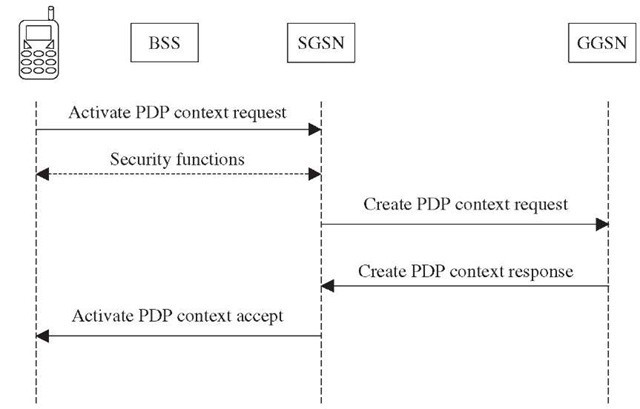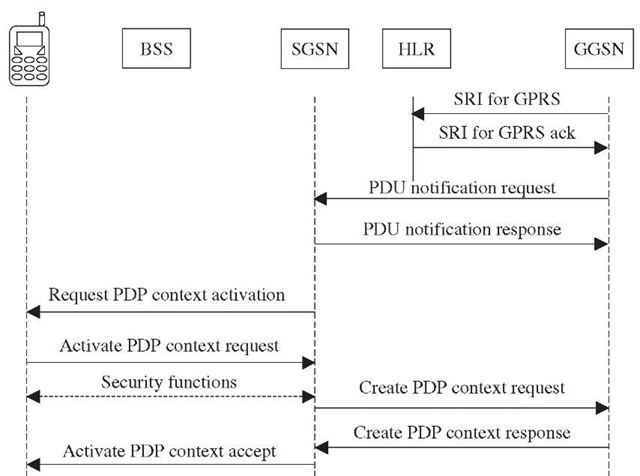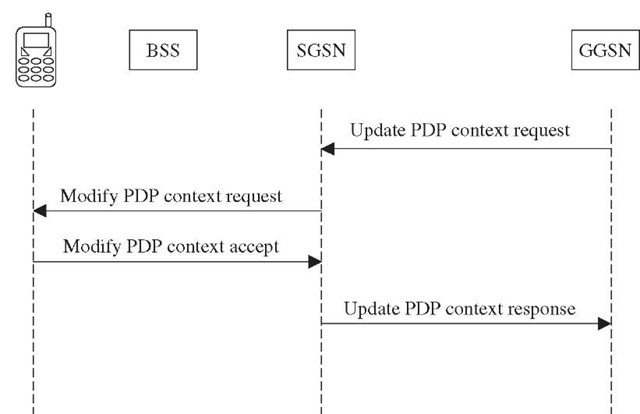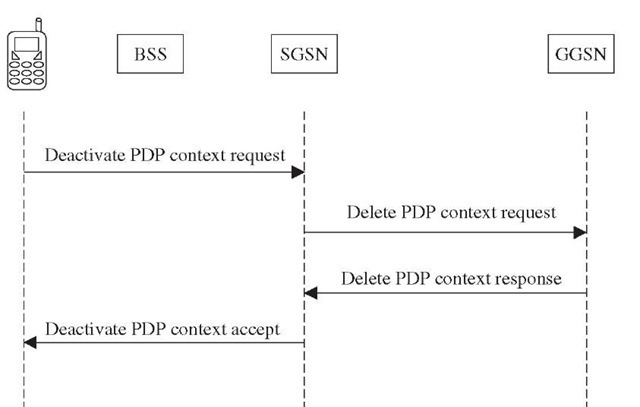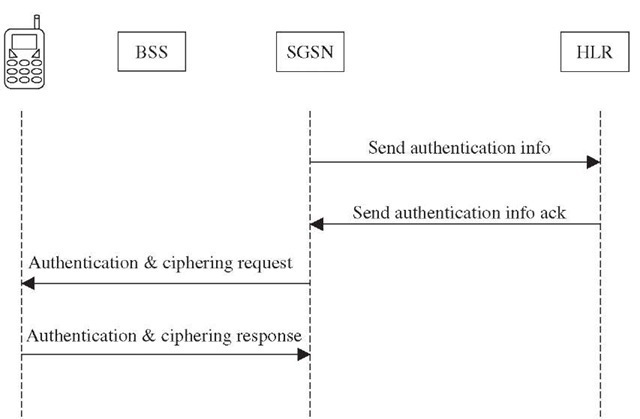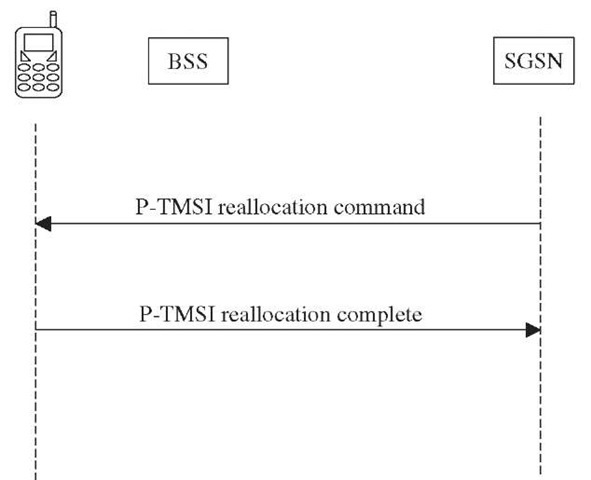Session management
MS-initiated PDP context activation. Once the MS is attached to the GPRS network, it can send and receive SMS. The MS must perform PDP context activation to use other GPRS services such as Internet access, intranet access, email, and MMS. This is required to establish a tunnel between the MS and the requested external packet data network for the data transfer. Figure 4-17 illustrates the PDP context activation procedure initiated by the MS.
The steps to successful PDP context activation are as follows:
1. The MS sends an activate PDP context message to the serving SGSN. This message contains following parameters.
■ PDP type (IP or X.25)
■ PDP address (static IP address or NULL for dynamic IP address)
■ APN (access point name: points to a certain packet data network or service a user wishes to access)
■ QoS requested
■ NSAPI
■ PDP configuration options
2. The SGSN may decide to perform standard security checks, i.e., ciphering and authentication, IMSI check, IMEI check, P-TMSI real-location, etc.)
3. The SGSN validates the activated DP context request for PDP type, PDP address, APN, etc. against the subscription. The SGSN also requests its local DNS to provide the GGSN address serving the requested APN.
Figure 4-17 MS-initiated PDP context activation procedure.
If any of the validation checks fail, the SGSN rejects the request and provides an appropriate cause value. On successful validation, the SGSN determines the tunnel ID (TID) by a combination of IMSI and NSAPI and sends a create PDP context request message to the GGSN. This message contains the following parameters.
■ PDP type (IP or X.25)
■ PDP address (static IP address or NULL for dynamic IP address)
■ APN (access point name: points to a certain packet data network or service a user wishes to access)
■ QoS negotiated
■ TID
■ NSAPI
■ MSISDN
■ Selection mode (subscribed or non subscribed APN)
■ PDP configuration options
4. The GGSN uses APN to identify the packet data network or services using DNS. It also uses DHCP or an external RADIUS server to get a PDP address for the MS. If the GGSN has been configured to use external PDN address allocation for the requested APN, the PDP address is set to 0.0.0.0, indicating that the PDP address shall be negotiated by the MS with the external PDN after the PDP context is activated.
5. The GGSN sends the create PDP context response to the SGSN. This message contains the following parameters.
■ PDP address
■ QoS negotiated
■ TID
■ PDP configuration options
■ BB protocol (TCP/UDP)
■ Cause
6. The SGSN inserts address parameters, i.e., NSAPI and GGSN address and sends an activate PDP context response message to the MS.
Network-initiated PDP context activation. When a GGSN receives a PDP PDU, it checks whether a PDP context exists for the PDP address. If not, the GGSN tries to deliver the PDP PDU by initiating a network-initiated PDP context request. Figure 4-18 illustrates this procedure. Network-initiated PDP context activation is possible only if the GGSN has static PDP information about the PDP address. The steps to successful PDP context activation are as follows:
1. On receiving a PDP PDU, the GGSN checks if there is static PDP information for that PDP address. If so, it starts storing subsequent PDP PDUs for that PDP address.
Figure 4-18 Network-initiated PDP context activation procedure.
It sends a send routing information for GPRS message to HLR. The HLR returns a send routing information for GPRS ack message with the following parameters:
■ IMSI
■ SGSN address
In cases where the request cannot be served, the HLR returns a negative acknowledgement with appropriate reason (e.g., IMSI unknown in the HLR).
2. The GGSN sends a PDU notification request to the SGSN. The message contains the following parameters:
■ IMSI
■ PDP type
■ PDP address
■ APN
The SGSN returns a PDP notification response, indicating to the GGSN that it will request the MS to activate the PDP context.
3. The SGSN sends a request PDP context activation message to the MS with the following parameters:
■ PDP type
■ PDP address
■ APN
4. The MS then initiates a PDP context activation procedure as defined in the previous section.
PDP context modification. By using this procedure, a previously negotiated PDP context can be modified on request from the MS, SGSN, or GGSN. The parameters, which can be modified, are as follows:
■ QoS negotiated
■ Radio priority
■ Packet flow ID
In addition to these, the GGSN can also request a PDP address change. Figure 4-19 illustrates the GGSN-initiated PDP context modification procedure.
The steps are as follows;
1. The GGSN sends an update PDP context request message to the SGSN. In this case, assume that the modification request is to change the previously negotiated QoS profile.
2. The SGSN checks the requested QoS profile against its capabilities, current load, and subscribed QoS profile. The SGSN then selects radio priority and packet flow ID on the basis of the negotiated QoS profile and sends a modify PDP context request message to the MS.
Figure 4-19 GGSN-initiated PDP context modification procedure.
3. The MS checks if it can accept the request. If yes, it sends a modify PDP context accept message to the SGSN. If no, it initiates deactivate PDP context procedure with the SGSN.
4. On receiving the modify PDP context accept message, the SGSN returns an update PDP context response message to the GGSN.
5. In cases where MS initiates the deactivate PDP context procedure, the SGSN follows the deactivation procedure.
PDP context deactivation. The MS, SGSN, or GGSN can initiate the PDP context deactivation procedure. Figure 4-20 illustrates the MS-initiated PDP context deactivation procedure.
1. The MS sends a deactivate PDP context message to the SGSN. The message contains a teardown indication.
2. The SGSN sends a delete PDP context request message to the GGSN. The message contains TEID, NSAPI, and a teardown indication.
3. The GGSN removes all the PDP contexts associated with the PDP address and returns a delete PDP context response message to the SGSN.
4. The SGSN returns a deactivate PDP context accept message to the MS.
Figure 4-20 Delete PDP context procedure.
Security function
The objectives of the security functions are to prevent an unauthorized user to access the services and keep user identity confidential.
Figure 4-20 Delete PDP context procedure. 4.6.3 Security function
The objectives of the security functions are to prevent an unauthorized user to access the services and keep user identity confidential.
Authentication procedure. The authentication procedure, as illustrated in Figure 4-21, is similar to the procedure used in GSM. The SGSN initiates the authentication procedure when a GPRS MS tries to attach to the network, using the GPRS attach procedure.
1. In cases where the SGSN has previously stored authentication triplet, then steps 1 and 2 are not required.
2. In cases where the SGSN does not have a previously stored authentication triplet, it requests the HLR to provide authentication triplet by sending a send authentication info message.
3. The HLR responds with a send authentication info ack message. This message has triplets consisting of RAND, SRES, and Kc.
■ RAND: random access number
■ SRES: signed response
■ Kc: ciphering key
4. The SGSN then sends an authentication and ciphering request with following information elements.
■ RAND
■ CKSN: ciphering key sequence number
■ Ciphering algorithm, i.e., A5
Figure 4-21 Authentication procedure.
5. The MS computes the SRES value and sends in its response to the SGSN using an authentication and ciphering response message. The MS then starts ciphering.
6. If the SRES from the MS matches with the one received from the HLR, the user is successfully authenticated.
P-TMSI reallocation procedure. The temporary logical link identity (TLLI) is a temporary identity used during a PDP session over the Um and Gb interfaces. The MS or the SGSN derives the value of TLLI by using P-TMSI. Only the MS and the SGSN are aware of the relationship between the IMSI and the TLLI. The SGSN may reallocate P-TMSI any time. The MS is forced to compute a new TLLI. The P-TMSI reallocation procedure, as illustrated in Figure 4-22, is initiated by the SGSN any time, or it can be included in the GPRS attach or RA update procedure.
1. The SGSN sends a P-TMSI reallocation command to the MS. The message contains the following information elements:
■ New P-TMSI
■ P-TMSI signature (optional)
■ RAI
2. The MS responds with a P-TMSI reallocation complete message to the SGSN.
Figure 4-22 P-TMSI reallocation procedure.
